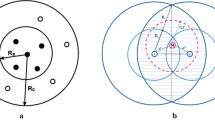Abstract
We study the tradeoffs involved in the energy-efficient localization and tracking of mobile targets by a wireless sensor network. Our work focuses on building a framework for evaluating the fundamental performance of tracking strategies in which only a small portion of the network is activated at any point in time. We first compare naive network operation with random activation and selective activation. In these strategies the gains in energy-savings come at the expense of increased uncertainty in the location of the target, resulting in reduced quality of tracking. We show that selective activation with a good prediction algorithm is a dominating strategy that can yield orders-of-magnitude energy savings with negligible difference in tracking quality. We then consider duty-cycled activation and show that it offers a flexible and dynamic tradeoff between energy expenditure and tracking error when used in conjunction with selective activation.
Access this chapter
Tax calculation will be finalised at checkout
Purchases are for personal use only
Preview
Unable to display preview. Download preview PDF.
Similar content being viewed by others
References
A. Cerpa et al., “Habitat monitoring: Application driver for wireless communications technology,” 2001 ACM SIGCOMM Workshop on Data Communications in Latin America and the Caribbean, Costa Rica, April 2001.
G.J. Pottie, W.J. Kaiser, “Wireless Integrated Network Sensors,” Communications of the ACM, vol. 43, no. 5, pp. 551–8, May 2000.
J. Warrior, “Smart Sensor Networks of the Future,” Sensors Magazine, March 1997.
D. Estrin, R. Govindan, J. Heidemann and S. Kumar, “Next Century Challenges: Scalable Coordination in Sensor Networks,” ACM/IEEE International Conference on Mobile Computing and Networks (MobiCom’ 99), Seattle, Washington, August 1999.
D. Estrin et al. Embedded, Everywhere: A Research Agenda for Networked Systems of Embedded Computers, National Research Council Report, 2001.
I. Akyildiz, W. Su, Y. Sankarasubramaniam, and E. Cayirci, “A Survey on Sensor Networks,” IEEE Communications Magazine, Vol. 40, No. 8, pp. 102–114, August 2002.
M. Chu, H. Haussecker, F. Zhao, “Scalable information-driven sensor querying and routing for ad hoc heterogeneous sensor networks.” International Journal on High Performance Computing Applications, vol. 16, no. 3, Fall 2002.
F. Zhao, J. Shin, J. Reich, “Information-Driven Dynamic Sensor Collaboration for Tracking Applications.” IEEE Signal Processing Magazine, March 2002.
Q. Fang, F. Zhao, L. Guibas, “Counting Targets: Building and Managing Aggregates in Wireless Sensor Networks.” Palo Alto Research Center Technical Report pp. 2002–10298, June 2002.
K. Chakrabarty, S. S. Iyengar, H. Qi, E.C. Cho, “Grid Coverage of Surveillance and Target location in Distributed Sensor Networks” To appear in IEEE Transaction on Computers, May 2002.
R. Bejar, B. Krishnamachari, C. Gomes, and B. Selman, “Distributed constraint satisfaction in a wireless sensor tracking system,” Workshop on Distributed Constraint Reasoning, International Joint Conference on Artificial Intelligence, Seattle, Washington, August 2001.
Jung, B. and Sukhatme, G.S. “Tracking Targets using Multiple Robots: The Effect of Environment Occlusion”, Autonomous Robots, 2002.
P. Ramanathan, “Location-centric Approach for Collaborative Target Detection, Classiffication, and Tracking,” IEEE CAS Workshop, 2002.
R. R. Brooks, P. Ramanathan, and A. Sayeed, “Distributed Target Tracking and Classification in Sensor Networks,” Proceedings of the IEEE, Invited Paper, Submitted for review, September 2002.
D. Li, K. Wong, Y. Hu and A. Sayeed, “Detection, Classification, Tracking of Targets in Micro-sensor Networks,” IEEE Signal Processing Magazine, pp. 17–29, March 2002
T. Clouqueur, V. Phipatanasuphorn, P. Ramanathan and K. K. Saluja, “Sensor Deployment Strategy for Target Detection,” The First ACM International Workshop on Wireless Sensor Networks and Applications (WSNA’02), Sep. 2002.
J. Liu, P. Cheung, L. Guibas, and F. Zhao, “A Dual-Space Approach to Tracking and Sensor Management in Wireless Sensor Networks,” The First ACM International Workshop on Wireless Sensor Networks and Applications (WSNA’02), Sep. 2002.
J. Reich, SensIT Collaborative Signal Processing Scenario Discussions, (http://www2.parc.com/spl/projects/cosense/pub/tracking_benchmarks.pdf).
S. Megerian, F. Koushanfar, G. Qu, G. Veltri, M. Potkonjak, “Exposure In Wireless Sensor Networks: Theory And Practical Solutions”, Journal of Wireless Networks, Vol. 8, No. 5, ACM Kluwer Academic Publishers, pp. 443–454, September 2002.
S. Meguerdichian, F. Koushanfar, G. Qu, M. Potkonjak, “Exposure In Wireless Ad Hoc Sensor Networks”, International Conference on Mobile Computing and Networking (MobiCom’ 01), pp. 139–150, Rome, Italy, July 2001.
R. Brooks, and C. Griffin, “Traffic model evaluation of ad hoc target tracking algorithms,” Journal of High Performance Computer Applications, Accepted, 2002.
R. Brooks, C. Griffin, and D. S. Friedlander, “Self-Organized distributed sensor network entity tracking,” International Journal of High Performance Computer Applications, special issue on Sensor Networks, vol. 16, no. 3, Fall 2002
J. Moore, T. Keiser, R. R. Brooks, S. Phoha, D. Friedlander, J. Koch, A. Reggio, and N. Jacobson, “Tracking Targets with Self-Organizing Distributed Ground Sensors,” 2003 IEEE Aerospace Conference, Invited Paper, Accepted for publication, November 2002.
Author information
Authors and Affiliations
Editor information
Editors and Affiliations
Rights and permissions
Copyright information
© 2003 Springer-Verlag Berlin Heidelberg
About this paper
Cite this paper
Pattem, S., Poduri, S., Krishnamachari, B. (2003). Energy-Quality Tradeoffs for Target Tracking in Wireless Sensor Networks. In: Zhao, F., Guibas, L. (eds) Information Processing in Sensor Networks. IPSN 2003. Lecture Notes in Computer Science, vol 2634. Springer, Berlin, Heidelberg. https://doi.org/10.1007/3-540-36978-3_3
Download citation
DOI: https://doi.org/10.1007/3-540-36978-3_3
Published:
Publisher Name: Springer, Berlin, Heidelberg
Print ISBN: 978-3-540-02111-7
Online ISBN: 978-3-540-36978-3
eBook Packages: Springer Book Archive




